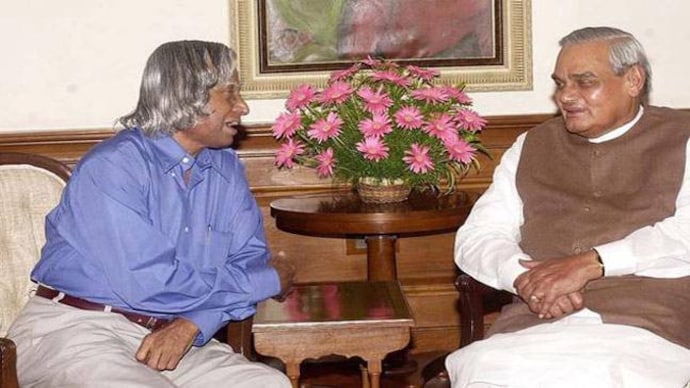National Technology Day: Why country remembers 'Missile Man' APJ Abdul Kalam and Vajpayee today
India celebrates National Technology Day every year since 1999 to commemorate the successful carrying out of the nuclear test at Pokhran in Rajasthan.

In Short
- India observes 19th National Technology Day to commemorate Pokhran nuclear test.
- India is observing the day every year since 1999.
- PM Modi pays respects to Kalam and Vajpayee while greeting the scientists.
The country observes 19th National Technology Day today to commemorate the successful carrying out of the nuclear test at Pokhran in Rajasthan on this day. On the same day India performed successful test firing of the Trishul Missile and test flying the first indigenous aircraft 'Hansa-3'.
Under the then prime minister Atal Bihari Vajpayee, the country started observing the day as National Technology Day every year since 1999. The man behind the successes of these milestones was APJ Abdul Kalam, who went on to become the 11th president of India on July 25, 2002.
It is 15 years later that the country is preparing to choose its new president after incumbent Pranab Mukherjee's term ends in July.
PM MODI REMEMBERS KALAM AND VAJPAYEE
In a series of tweets today, Prime Minister Narendra Modi paid his respects to Kalam and Vajpayee while greeting the scientists.
Greetings to everyone, especially our industrious scientists and those passionate about technology, on National Technology Day.- Narendra Modi (@narendramodi) May 11, 2017
We remain grateful to our scientists & the then political leadership for the courage shown in Pokhran in 1998. https://t.co/l2QMStppQ1- Narendra Modi (@narendramodi) May 11, 2017
Let us further integrate technology in our society. The transformative potential of technology is immense. https://t.co/dRIw5kdTx9- Narendra Modi (@narendramodi) May 11, 2017
Ofcourse! The stellar accomplishments and contribution of Dr. Kalam will always be remembered. https://t.co/ywSsCX0yqw- Narendra Modi (@narendramodi) May 11, 2017
THE POKHRAN II TESTS
India conducted five tests on May 11 and 13, 1998, at the Pokhran range, which included a 45 kiloton (kt) thermonuclear device, known as a 'hydrogen bomb' in common parlance.
The other tests on May 11 included a 15 kt fission device and a 0.2 kt sub-kiloton device. The two simultaneous nuclear tests on May 13 were also in the sub-kiloton range - 0.5 and 0.3 kt.
As Director-General of the Defence Research and Development Organisation (DRDO), Kalam had spearheaded the nuclear tests in 1998. He was also the scientific adviser to the then defence minister. R Chidambaram, who was the chairman of the Atomic Energy Commission and Anil Kakodkar, the then Director of the Bhabha Atomic Research Centre, were the other two key players in the Pokhran-II tests.
Kalam was also associated with the first Pokhran nuclear test conducted on May 18, 1974 when Indira Gandhi was the prime minister.
Later, giving the details of the successful test, he had revealed that there was a detailed review, based on the two experimental results: seismic measurement close to the site and around, and radioactive measurement of the material after post shot drill in the test site. From these data, it was established by the project team that the design yield of the thermo-nuclear test had been obtained, Kalam had claimed.
MISSILE MAN OF INDIA
He worked his way to become the driving force behind India's space and missile programmes and came to be known as the 'Missile Man of India'.
Kalam's research and educational leadership brought him great laurels and prestige, prompting the Government to initiate an advanced missile programme under his directorship. He was the chief executive of the Integrated Guided Missile Development Programme and was instrumental in the development of the Agni and Prithvi Missiles.
The former President visualised a distinctive profile of India by the year 2020 which included responsive, transparent and corruption-free governance and where the nation was proud of its leadership. He reposed great faith in the youth of the country and believed that through proper guidance, they would be able to transform India into a developed nation, which was one of his greatest dreams.
BHARAT RATNA
Kalam was awarded the Padma Bhushan in 1981, Padma Vibhushan in 1990 and Bharat Ratna - the highest civilian honour - in 1997. The Bharat Ratna came just a year before he played a key role in the Pokhran test.
Born on October 15, 1931, Kalam went on to become one of the most celebrated aerospace and defence scientists in the country. He piloted India's civilian space programme, military missile development efforts and ballistic missile and launch vehicle technology to the heights which it has reached today.
He became the head of DRDO in 1992 and the principal scientific advisor to the Indian government in 1999 with the rank of a cabinet minister. He held the post till 2001.
He died on July 27, 2015, doing what he loved most - while giving a lecture in IIT, Shillong.
However, a grateful country still remembers him and, while observing the National Technology Day, pays tribute to him besides Atal Bihari Vajpayee.
WATCH:
How ISRO's naughty boy rocket launched South Asia Satellite GSAT-9
ALSO READ:
On National Technology Day, PM Modi hails Vajpayee's courage for conducting Pokhran nuclear tests
India's GSAT-9 launch: Will Modi's space diplomacy help contain China's influence in the region?
